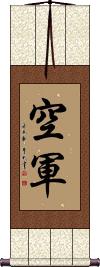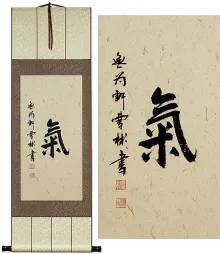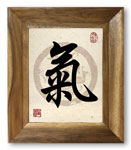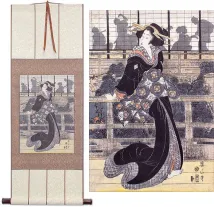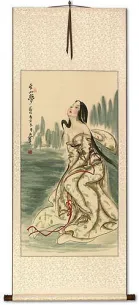Many custom options...
And formats...

Air Force in Chinese / Japanese...
Buy an Air Force calligraphy wall scroll here!
Personalize your custom “Air Force” project by clicking the button next to your favorite “Air Force” title below...
Air Force
空軍 is “Air Force” in Chinese, Japanese Kanji, and old Korean Hanja.
If you're an airman, this could be the title for you.
Life Energy / Spiritual Energy
Chi Energy: Essence of Life / Energy Flow
This 氣 energy flow is a fundamental concept of traditional Asian culture.
氣 is romanized as “Qi” or “Chi” in Chinese, “Gi” in Korean, and “Ki” in Japanese.
Chi is believed to be part of everything that exists, as in “life force” or “spiritual energy.” It is most often translated as “energy flow” or literally as “air” or “breath.” Some people will simply translate this as “spirit,” but you must consider the kind of spirit we're talking about. I think this is weighted more toward energy than spirit.
The character itself is a representation of steam (or breath) rising from rice. To clarify, the character for rice looks like this: ![]()
Steam was apparently seen as visual evidence of the release of “life energy” when this concept was first developed. The Qi / Chi / Ki character is still used in compound words to mean steam or vapor.
The etymology of this character is a bit complicated. It's suggested that the first form of this character from bronze script (about 2500 years ago) looked like these samples: 

However, it was easy to confuse this with the character for the number three. So the rice radical was added by 221 B.C. (the exact time of this change is debated). This first version with the rice radical looks like this: 
The idea of Qi / Chi / Ki is really a philosophical concept. It's often used to refer to the “flow” of metaphysical energy that sustains living beings. Yet there is much debate that has continued for thousands of years as to whether Qi / Chi / Ki is pure energy or consists partially or fully of matter.
You can also see the character for Qi / Chi / Ki in common compound words such as Tai Chi / Tai Qi, Aikido, Reiki, and Qi Gong / Chi Kung.
In the modern Japanese Kanji, the rice radical has been changed into two strokes that form an X.
![]() The original and traditional Chinese form is still understood in Japanese, but we can also offer that modern Kanji form in our custom calligraphy. If you want this Japanese Kanji, please click on the character to the right instead of the “Select and Customize” button above.
The original and traditional Chinese form is still understood in Japanese, but we can also offer that modern Kanji form in our custom calligraphy. If you want this Japanese Kanji, please click on the character to the right instead of the “Select and Customize” button above.
More language notes: This is pronounced like “chee” in Mandarin Chinese, and like “key” in Japanese.
This is also the same way to write this in Korean Hanja where it is Romanized as “gi” and pronounced like “gee” but with a real G-sound, not a J-sound.
Though Vietnamese no longer use Chinese characters in their daily language, this character is still widely known in Vietnam.
See Also: Energy | Life Force | Vitality | Life | Birth | Soul
This in-stock artwork might be what you are looking for, and ships right away...
Gallery Price: $106.00
Your Price: $58.77
Gallery Price: $90.00
Your Price: $49.88
Gallery Price: $108.00
Your Price: $59.88
Gallery Price: $200.00
Your Price: $79.88
Gallery Price: $60.00
Your Price: $39.88
Not the results for Air Force that you were looking for?
Below are some entries from our dictionary that may match your Air Force search...
| Characters If shown, 2nd row is Simp. Chinese |
Pronunciation Romanization |
Simple Dictionary Definition |
空 see styles |
kòng kong4 k`ung kung kuu / ku くう |
More info & calligraphy: Sky / Ether / Void / Emptiness / Unreality(1) empty air; sky; (2) {Buddh} shunyata (the lack of an immutable intrinsic nature within any phenomenon); emptiness; (3) (abbreviation) (See 空軍) air force; (noun or adjectival noun) (4) fruitlessness; meaninglessness; (noun or adjectival noun) (5) (See 五大・1) void (one of the five elements); (can be adjective with の) (6) {math} empty (e.g. set); (female given name) Ron śūnya, empty, void, hollow, vacant, nonexistent. śūnyatā, 舜若多, vacuity, voidness, emptiness, non-existence, immateriality, perhaps spirituality, unreality, the false or illusory nature of all existence, the seeming 假 being unreal. The doctrine that all phenomena and the ego have no reality, but are composed of a certain number of skandhas or elements, which disintegrate. The void, the sky, space. The universal, the absolute, complete abstraction without relativity. There are classifications into 2, 3, 4, 6, 7, 11, 13, 16, and 18 categories. The doctrine is that all things are compounds, or unstable organisms, possessing no self-essence, i.e. are dependent, or caused, come into existence only to perish. The underlying reality, the principle of eternal relativity, or non-infinity, i.e. śūnya, permeates all phenomena making possible their evolution. From this doctrine the Yogācārya school developed the idea of the permanent reality, which is Essence of Mind, the unknowable noumenon behind all phenomena, the entity void of ideas and phenomena, neither matter nor mind, but the root of both. |
空軍 空军 see styles |
kōng jun kong1 jun1 k`ung chün kung chün kuugun / kugun くうぐん |
More info & calligraphy: Air Forceair force |
AF see styles |
ee efu; eeefu(sk) エー・エフ; エーエフ(sk) |
(1) {photo} (See オートフォーカス) autofocus; AF; (2) (See 可聴周波) audio frequency; (3) (See 空軍) air force; (noun/participle) (4) (vulgar) (slang) (See アナルファック) anal sex |
三軍 三军 see styles |
sān jun san1 jun1 san chün sangun さんぐん |
(in former times) upper, middle and lower army; army of right, center and left; (in modern times) the three armed services: Army, Navy and Air Force (noun - becomes adjective with の) great army; mighty host; whole army |
建軍 see styles |
kengun けんぐん |
founding of an army (navy, air force) |
空佐 see styles |
kuusa / kusa くうさ |
(Self Defense Force's Air Force) colonel (defence); lieutenant; major |
空将 see styles |
kuushou / kusho くうしょう |
(Self Defense Force's Air Force) general (defence); lieutenant; major |
空尉 see styles |
kuui / kui くうい |
(Self Defense Force's Air Force) captain (defence); lieutenant |
空自 see styles |
kuuji / kuji くうじ |
(abbreviation) (See 航空自衛隊・こうくうじえいたい) Air Self-Defense Force; ASDF; (o) Air Self-Defense Force (abbreviation); ASDF |
空防 see styles |
kōng fáng kong1 fang2 k`ung fang kung fang |
air force; air defense |
聯隊 联队 see styles |
lián duì lian2 dui4 lien tui rentai れんたい |
wing (of an air force); sports team representing a combination of entities (e.g. United Korea) (noun - becomes adjective with の) regiment |
風情 风情 see styles |
fēng qíng feng1 qing2 feng ch`ing feng ching fuzei(p); fuujou / fuze(p); fujo ふぜい(P); ふうじょう |
mien; bearing; grace; amorous feelings; flirtatious expressions; local conditions and customs; wind force, direction etc (1) (ふぜい only) taste; elegance; charm; (2) appearance; air; (suffix) (3) (ふぜい only) (humble language) (derogatory term) the likes of ...; lowly people such as ... |
上等兵 see styles |
shàng děng bīng shang4 deng3 bing1 shang teng ping joutouhei / jotohe じょうとうへい |
private first class (army rank) {mil} private first-class (army); airman first class (air force); lance corporal (US Marines; Commonwealth military); seaman (navy) |
海空軍 海空军 see styles |
hǎi kōng jun hai3 kong1 jun1 hai k`ung chün hai kung chün |
navy and air force |
爆撃隊 see styles |
bakugekitai ばくげきたい |
air strike force; bomber squadron |
空軍機 see styles |
kuugunki / kugunki くうぐんき |
air force aircraft |
米空軍 see styles |
beikuugun / bekugun べいくうぐん |
US Air Force |
陸海空 see styles |
rikukaikuu / rikukaiku りくかいくう |
(1) land, sea and air; (2) (See 陸海空軍) army, navy and air force |
飛行隊 see styles |
hikoutai / hikotai ひこうたい |
flying corps; air force |
戦略空軍 see styles |
senryakukuugun / senryakukugun せんりゃくくうぐん |
strategic air force |
極東空軍 see styles |
kyokutoukuugun / kyokutokugun きょくとうくうぐん |
(org) Far East Air Force; (o) Far East Air Force |
空軍一號 空军一号 see styles |
kōng jun yī hào kong1 jun1 yi1 hao4 k`ung chün i hao kung chün i hao |
Air Force One, US presidential jet |
空軍協会 see styles |
kuugunkyoukai / kugunkyokai くうぐんきょうかい |
(org) Air Force Association; AFA; (o) Air Force Association; AFA |
空軍司令 空军司令 see styles |
kōng jun sī lìng kong1 jun1 si1 ling4 k`ung chün ssu ling kung chün ssu ling |
air commodore; top commander of air force |
空軍基地 空军基地 see styles |
kōng jun jī dì kong1 jun1 ji1 di4 k`ung chün chi ti kung chün chi ti kuugunkichi / kugunkichi くうぐんきち |
air base air (force) base |
空軍大尉 see styles |
kuuguntaii / kuguntai くうぐんたいい |
air force captain |
陸海空軍 陆海空军 see styles |
lù hǎi kōng jun lu4 hai3 kong1 jun1 lu hai k`ung chün lu hai kung chün rikukaikuugun / rikukaikugun りくかいくうぐん |
army, navy and air force army, navy and air force; land, sea and air forces |
ドイツ空軍 see styles |
doitsukuugun / doitsukugun ドイツくうぐん |
(org) German Air Force; Luftwaffe; (o) German Air Force; Luftwaffe |
航空自衛隊 航空自卫队 see styles |
háng kōng zì wèi duì hang2 kong1 zi4 wei4 dui4 hang k`ung tzu wei tui hang kung tzu wei tui koukuujieitai / kokujietai こうくうじえいたい |
air self-defense force {mil} Japan Air Self-Defense Force; JASDF; (o) Air Self-Defense Force; ASDF |
航空警務隊 see styles |
koukuukeimutai / kokukemutai こうくうけいむたい |
military police brigade (air force) |
Click here for more Air Force results from our dictionary
The following table may be helpful for those studying Chinese or Japanese...
| Title | Characters | Romaji (Romanized Japanese) | Various forms of Romanized Chinese | |
| Air Force | 空軍 空军 | kuugun / kugun | kōng / kong1 jun1 / kong jun / kongjun | k`ung chün / kungchün / kung chün |
| Life Energy Spiritual Energy | 氣 气 / 気 | ki | qì / qi4 / qi | ch`i / chi |
| In some entries above you will see that characters have different versions above and below a line. In these cases, the characters above the line are Traditional Chinese, while the ones below are Simplified Chinese. | ||||
Successful Chinese Character and Japanese Kanji calligraphy searches within the last few hours...
